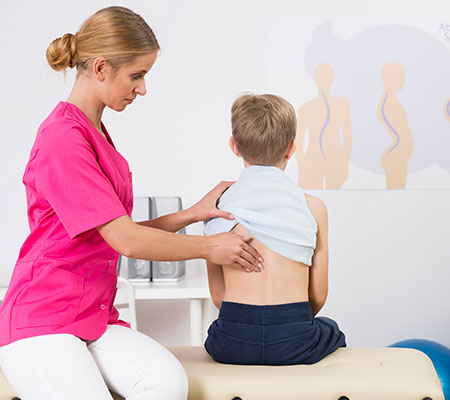
The Schroth method uses a combined physical therapy and breathing approach to help treat scoliosis – providing a non-surgical option for children and adults.
Erik Smith, physical therapist at Marshfield Clinic Health System, is actively using this method to treat patients.
“The research is very positive out there as far as seeing reduction in curves, but our main goal is just to maintain the curve so it doesn’t progress,” said Smith.
The intervention attempts to eliminate or minimize curve progression up until surgery is recommended at 45-50 degrees. It is best when done in unison with a brace.
There is basically a formula based on how old a patient is, where they are in their growth spurt and how big their curve is. That tells us whether they need to go into a brace,” said Smith. “We teach them even within their brace to use their muscles to basically hold themselves in even a better position than their brace is.”
Four steps to the Schroth method
The Schroth method includes a four-step process that is completed during 10-12 sessions performed twice a week:
- Proper starting positions
A physical therapist directs the patient and makes adjustments as needed in various different positions, such as sitting. This ensures the patient is in proper alignment to get a good starting point. - Elongated breathing
A physical therapist then promotes proper breathing techniques. This creates more space in the patient’s spine so there is more room to work with the spine. - Maintain and activate
After the patient has completed elongated breathing, they need to maintain arms, shoulders and pelvis position. The physical therapist then teaches the patient to activate their muscles and breathing to promote proper spine positioning. - Functional stabilization
After the patient demonstrates consistent ability with the first three steps, the physical therapist works with the patient to maintain the corrective position while completing functional activities like going from sitting to standing.
“We teach them how to use their muscles to put their spine in the best alignment they can,” said Smith. “We are trying to elongate their trunk, and teach them how to use their muscles to push their curves in the right direction.”
A corrective posture is the goal
Eventually the goal is to help the patient do everyday tasks in the corrective posture. This includes making sure the patient can do this while playing sports such as volleyball or basketball.
We are not here to tell them they have to stop doing the activities they like to do. It is more about how can we get them into good position when they are doing those activities,” said Smith.
If additional problems are found during these sessions, Smith and Jensen also perform traditional physical therapy with their patients. These problems can sometimes impede treatment effectiveness.
For more information about the Schroth method, contact your child’s pediatrician or primary care provider.






Leave a Reply